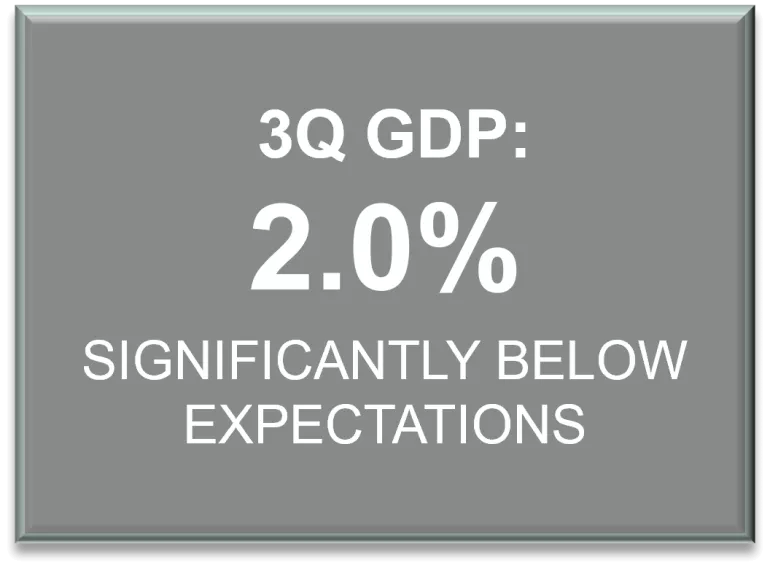November Economic Commentary: Labor Market Shows Slight Improvement Even as Economic Recovery Is Challenged on Multiple Fronts

Chief Economist
Pohlad Companies
During the past few weeks, we’ve had the usual updates on a number of economic measures. The most important report, however, came after last week’s Federal Reserve Open Market Committee (FOMC) meeting. I’ll discuss the monthly reports below, but it is always good to focus on messages coming from the Fed. The Fed controls the money in our economy, and it has been their extraordinary response to COVID-19 via monetary policy (along with fiscal policy from Congress) that has enabled the economy to recover quickly, and in the process, develop the many imbalances between supply and demand we see today.
GDP and Personal Consumption
We received our first reading of real GDP in 3Q-21 and, as expected, it showed significant slowing in economic activity as a result of the emergence of the Delta variant of the virus, the shortage of consumer goods, and the waning impact of the fiscal stimulus issued in the spring. 3Q-21 real annualized GDP slowed to 2.0% from 6.7% in 2Q-21. As recently as early July, the expectation was that 3Q-21 real GDP would register 7%.
Personal consumption expenditures in 3Q-21 grew at a 1.6% annualized pace compared with a 12% rate in 2Q-21. Consumer expenditures make up about 70% of GDP, so as the consumer goes, so goes GDP. Economic growth will likely enjoy a bounce in 4Q-21 as the Delta variant subsides and consumer spending rebounds going into the holidays, but growth is expected to continue to slow (not contract) over the coming year.
Inflation
Inflation pressures are the key risk for monetary policy. Headline inflation is at 5.4% year over year and the Fed’s preferred measure of inflation—the Core Personal Consumption Expenditure Index—is at a 30-year high of 3.6%. Higher core inflation is no longer just being driven by a handful of transitory factors; longer-lasting cyclical acceleration in inflation is also developing. The Employment Cost Index just recorded its biggest quarterly jump in two decades with a 1.3% increase for 3Q-21, resulting in a year-over-year increase of 3.7%. Because wage growth is much stickier than the transitory inflation pressures associated with the economy, the current elevated inflation may be longer lasting than initially expected.
Employment
The October employment report indicated that the labor market is recovering from concerns about the Delta variant with non-farm payrolls registering a 531,000 increase coupled with strong upward revisions to the prior two reports. The household survey saw a 359,000 increase, but with only a 104,000 increase in the labor force, the unemployment rate fell to 4.6% from 4.8%.
The bigger concern is on the supply side of the labor market. Payrolls are still 4.2 million below the pre-pandemic level, and there have been no signs of improvement in labor force participation since May. When the labor shortages became evident earlier in the year, there were reasons to believe that they were temporary. But six months later, unemployment benefits have expired and schools have re-opened, and there is still no improvement in labor force participation.
With the quality of labor as the number one issue for small businesses, the broad-based labor shortages are resulting in average hourly wages now growing at 4.9% year over year and likely to continue to move higher as a record number of small firms plan to increase compensation to attract and retain employees according to the latest small business survey.
What to Watch
Importantly, the Fed announced last week that they are going to start tapering their $120-billion-per-month asset purchases by $15 billion per month. The tapering will begin this month, and if continued at this pace, will be completed in mid-2022. The first increase in interest rates is now expected in mid- to late-2022.
The two biggest challenges for the U.S. economy at this time are elevated inflation pressures and a diminished work force. This puts the Fed in a difficult position with their two mandates (price stability and maximum employment) requiring potentially conflicting policy responses. Inflation is far above the Fed’s 2% objective, suggesting the need for some tightening of monetary policy, but employment is still considerably below pre-pandemic levels, which might cause the Fed to remain accommodative.
As discussed previously, the economy is moving back to trend-like growth rates of 2.5% - 3.0%. However, the ongoing imbalance between supply and demand (both in materials and in labor) are creating an environment where the potential for a policy error is very real.
Insights
Research to help you make knowledgeable investment decisions
